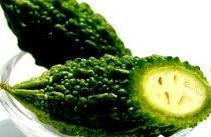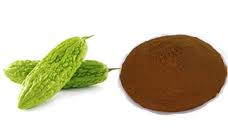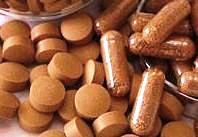 Bitter melon is a member of the Cucurbitaceae family (cucumbers, pumpkins and watermelons). The bitter melon fruit, sometimes called bitter gourd or wild cucumber, grows in tropical and sub-tropical climates. It is very nutritious vegetable having high therapeutic value. It is used both as food and in medicine to treat type2 diabetes, cancer, infections, HIV (AIDS), menstrual disorder and immune disorders.
Bitter melon is a member of the Cucurbitaceae family (cucumbers, pumpkins and watermelons). The bitter melon fruit, sometimes called bitter gourd or wild cucumber, grows in tropical and sub-tropical climates. It is very nutritious vegetable having high therapeutic value. It is used both as food and in medicine to treat type2 diabetes, cancer, infections, HIV (AIDS), menstrual disorder and immune disorders.
Chemical constituents from whole plants, fruits, and seeds of bitter melon (Momordica charantia) have been isolated and described as following:
Previously, the researchers have reported that extract of bitter melon has sugar- and fat-lowering properties. The compounds present in bitter melon including vicine, charantin, and polypeptide-P increase glucose uptake and glycogen synthesis in the liver, muscle, and adipose tissue, and improve glucose tolerance.
People with type2 diabetes have an impaired ability to convert the sugar in their blood into energy in their muscles. This is partly because they don’t produce enough insulin, and partly because their fat and muscle cells don’t use insulin effectively, a phenomenon known as ‘insulin resistance’. Studies have shown that bitter melon extract (BTE) repairs damaged beta-cells, increases insulin levels, and also enhance the sensitivity of insulin. It inhibits the absorption of glucose by inhibiting glucosidase and also suppresses the activity of disaccharidases in the intestine.
Bitter gourd (Momordica Charantia): A dietary approach to hyperglycemia.
Effects of Momordica charantia on insulin resistance and visceral obesity in mice on high-fat diet.
Wild bitter gourd improves metabolic syndrome: a preliminary dietary supplementation trial.
AMP-activated protein kinase (AMPK) is a fuel-sensing enzyme that is activated when cells experience energy deficiency and conversely suppressed in surfeit of energy supply. AMPK regulates lipid, cholesterol and glucose metabolism in specialized metabolic tissues, such as liver, muscle and adipose tissue. This function has made AMPK a key therapeutic target in patients with type2 diabetes. AMPK activation improves insulin sensitivity via multiple mechanisms. Once activated by ATP depletion, it switches on ATP-producing catabolic pathways and switches off ATP-consuming anabolic pathways, via direct phosphorylation of metabolic enzymes and via effects on gene expression.
Exercise activates AMPK in muscle, which in turn mediates the movement of glucose transporters to the cell surface, a very important step in the uptake of glucose from the circulation into tissues in the body. This is a major reason that exercise is recommended as part of the normal treatment program for someone with type2 diabetes. The compounds isolated in bitter melon perform a very similar action to that of exercise, in that they activate AMPK. Metformin, a drug widely used to treat type2 diabetes, also activates AMPK. Metformin is a chemical derivative of guanidine, the active ingredient in the french lilac (Galega officinalis) used to treat diabetes in the Middle Ages.
AMP-activated protein kinase: balancing the scales.
Antidiabetic potentials of Momordica charantia: multiple mechanisms behind the effects.
AMPK is a matabolic tumor suppressor. Because AMPK activation inhibits most biosynthetic pathways and causes cell cycle arrest, it should also have a cytostatic, tumor suppressor effect. Furthermore, AMPK activates p53, a famous tumor suppressor protein that is mutated in 50% of the cancers. Loss or mutation of p53 is commonly found in cancer rendering tumor cells resistant to a variety of apoptotic stimuli. AMPK promotes p53 acetylation and apoptosis of cancer cells, and activates a p53-dependent cell cycle arrest.
AMPK as a metabolic tumor suppressor: control of metabolism and cell growth.
The LKB1-AMPK pathway: metabolism and growth control in tumour suppression.
AMPK Promotes p53 Acetylation via Phosphorylation and Inactivation of SIRT1 in Liver Cancer Cells.
 Metformin is an anti-cancer drug by virtue of its ability to increase AMPK activity. Unfortunately, it is a prescription drug and has certain side effects. Bitter melon extract (BME) has almost no side effects and is available to anyone who wants it. More recently BME has been found to possess anti-cancer activities via its effect on a variety of biological pathways involved in mutagenesis, oncogene expression, cell cycle regulation, apoptosis, tumorigenesis and metastasis. These findings suggest that taking BME can prevent or treat a variety of cancers, including breast, liver, prostate, and colon cancer and leukemia. However, it has not been ascertained if or which alkaloids, polypeptides, or combination of these chemicals, are responsible for the medicinal effect.
Metformin is an anti-cancer drug by virtue of its ability to increase AMPK activity. Unfortunately, it is a prescription drug and has certain side effects. Bitter melon extract (BME) has almost no side effects and is available to anyone who wants it. More recently BME has been found to possess anti-cancer activities via its effect on a variety of biological pathways involved in mutagenesis, oncogene expression, cell cycle regulation, apoptosis, tumorigenesis and metastasis. These findings suggest that taking BME can prevent or treat a variety of cancers, including breast, liver, prostate, and colon cancer and leukemia. However, it has not been ascertained if or which alkaloids, polypeptides, or combination of these chemicals, are responsible for the medicinal effect.
Momordica charantia leaf extract suppresses rat prostate cancer progression in vitro and in vivo.
Bitter gourd (Momordica charantia): a potential mechanism in anti-carcinogenesis of colon.
Glycosidic inhibitors of melanogenesis from leaves of Momordica charantia.
In vivo antitumor activity of the bitter melon (Momordica charantia).
Tumors usually consist of mixed populations of malignant cells, some of which are drug-sensitive while others are drug-resistant. Chemotherapy kills drug-sensitive cells, but leaves behind a higher proportion of drug-resistant cells. As the tumor begins to grow again, chemotherapy may fail because the remaining tumor cells are now resistant. Resistance to therapy has been correlated to the presence of at least two molecular “pumps” in tumor-cell membranes that actively expel chemotherapy drugs from the interior.
This allows tumor cells to avoid the toxic effects of the drug or molecular processes within the nucleus or the cytoplasm. The two pumps commonly found to confer chemoresistance in cancer are P-glycoprotein and the so-called multidrug resistance–associated protein (MRP). P-glycoprotein mediated multi-drug resistance (MDR) is a major barrier to the effective chemotherapy of many cancers. The good news is that bitter melon extract (BTE) also inhibits P-glycoprotein and can alter the pharmacokinetics of drugs by inhibiting the P-glycoprotein-mediated efflux.
The role of bitter melon traditionally, has been as a food and medicine. To the best of our knowledge in normal vegetable usage of bitter melon, no toxicity has been reported. However, high dose of bitter melon extract which is now available in the markets may cause some kind of toxic effect, like an overdose of any other polyphenolics. Also, covering on seed may be toxic in children, leading to vomiting, diarrhea, and death. Intake of the seed may lead to favism, especially those with G6PD deficiency. Bitter melon may also have additive effects when taken with other glucose-lowering agents.
 Bitter Melon-Zym (BM-Zym) contains naturally fermented, the purest, and most highly bioavailable wild bitter melon extract. But this is no ordinary fermentation. Fermentation is a process involving enzymes in which a compound rich in energy is broken down into simpler substances and is associated with the reduction of certain naturally-occurring toxins in plant foods. Natural substances are dependent on bioavailability to achieve the desired results. All too often, the benefits are not obtained because the normal digestive process degrades bioavailability, and typical carriers, if any are used, do not promote bioavailability. Active components of bitter melon extract (BME) must cross the intestinal barrier to facilitate bioavailability.
Bitter Melon-Zym (BM-Zym) contains naturally fermented, the purest, and most highly bioavailable wild bitter melon extract. But this is no ordinary fermentation. Fermentation is a process involving enzymes in which a compound rich in energy is broken down into simpler substances and is associated with the reduction of certain naturally-occurring toxins in plant foods. Natural substances are dependent on bioavailability to achieve the desired results. All too often, the benefits are not obtained because the normal digestive process degrades bioavailability, and typical carriers, if any are used, do not promote bioavailability. Active components of bitter melon extract (BME) must cross the intestinal barrier to facilitate bioavailability.
BM-Zym maintains the biologically active constituents for highest potency and action. BM-Zym offers all the naturally-balanced active principles while retaining and enhancing all the whole-plant synergistic benefits, thus making it not only one of the world’s finest and purest plant extracts, but also faster-acting and more assimilable than unfermented and unconcentrated Bitter Melon Fruit.
500 mg, 120 tablets (Fermented momordica charantia whole fruit standardized extract: 20% Bitter Principles containing Momordicosides & Charantin - 100 mg, 100% Kosher, 100% Naturally Fermented ingredients)
Dosage is 2,000 mg a day, take 500 mg 4 times. If necessary, we can increase the dose over time.